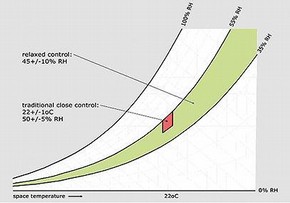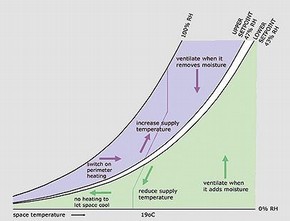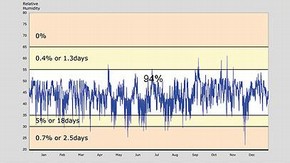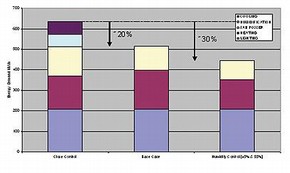Conservation Journal
Autumn 2009 Issue 58 special edition
Medieval & Renaissance Galleries: A passive approach to humidity control
During the design stage of the new Medieval & Renaissance Galleries (the project) the decision was taken to adopt a passive approach to environmental control. This article describes the rationale, analysis and benefits of this approach. The passive approach developed, exploits the massive nature of the building and uses sophisticated control techniques to minimise variations in humidity in the galleries but uses neither refrigeration nor humidification machinery to achieve its performance.
This article is primarily intended to describe the design measures developed for the control of humidity and temperature. Other environmental factors which affect the preservation of objects, such as lighting and dust filtration are not treated in detail.
During the design phase of the project the revision of the V&A environmental guidelines for conservation of objects in the Museum opened the opportunity of moving away from the traditional approach for environmental control. The traditional approach to environmental control relies on mechanical systems of air-conditioning to closely maintain the internal environment within a specified range of conditions. Such systems are energy intensive in use and require substantial space for machinery and considerable capital investment. Furthermore, in the case of the Medieval & Renaissance Galleries, the installation of such a system of air-conditioning would have required expensive alterations to the fabric of the building.
A comprehensive review, carried out by the V&A, of the objects to be included in the galleries and their previous display conditions highlighted that many of the objects were acclimatised to and displayed in a dry museum environment. This informed the environmental control systems design: object conservation should be prioritised over occupant comfort; on a seasonal basis relative humidity (RH) could be allowed to vary through a wider range than originally anticipated, between a minimum of 35% and maximum of 55% (45% +/- 10%); short-term fluctuations in RH should be minimised as far as possible and kept to less than a 10% variation in any twenty-four hour period; objects of higher sensitivity should be installed in showcases to further buffer them from environmental variations.
In addition to the conservation guidelines, the V&A sustainability policy also called for minimising the energy use of all new projects.

Figure 1. Target conditions for the Medieval & Renaissance Galleries

Figure 2. Control strategy to stabilise the RH environment.
Thus, the challenge to the design team was to develop a low energy system for environmental control that would provide the internal environment required for the long-term preservation of the collections. Such an approach was found and developed for the project and its strategy and performance are described below.
The target conditions (Figure 1) illustrates the range of thermodynamic conditions (shown on a psychrometric chart) permitted by the V&A environmental guidelines for conservation in the project and compares them with a more traditional mechanical air-conditioning system (with a control band of 22ºC ±1ºC and 50% ±5%RH). As can be seen, there is a far wider range of conditions permitted by the approach adopted for the project.
The internal environment of the galleries is subject to many constantly changing influences including, amongst others, internal loads generated by visitors, heat released by electric lighting, infiltration of outside air through the building fabric, and external temperature and humidity variations conducted and convected into the interior. The design strategy developed for stabilising the RH environment involves exploiting the external air condition together with the ventilation and heating of the interior. Examples are given below describing how this works in practice. Reference is made to Figure 2, which illustrates the environmental system behaviour depending on interior and exterior conditions (again using a psychrometric chart).
'Set points' are included here that govern the system behaviour: the upper and lower set points are tight control targets for the environmental control system that allow it to react before the upper and lower limits are reached.
Case 1: Internal RH above the upper RH set point. When the internal RH is above the upper set point (47%) the system aims to increase the temperature and lower the moisture content in order to bring the RH back to within the set points. Perimeter heating may be switched on to increase temperature and so lower RH. Air is supplied at a set point of 19°C initially with the set point increased as RH rises, note that, since there is no mechanical cooling of outside air, it will be supplied at whichever is greater of the set point or the outside air temperatures. To lower the moisture content the ventilation system is only switched on when the external moisture content is less than the internal moisture content.
Case 2: Internal RH above the upper RH set point. When the internal RH is below the lower set point (43%) the system operates in reverse and aims to reduce the temperature and increase the moisture content to bring the RH back to within the set points. Ventilation is only run when the external moisture content is higher than the internal moisture content. Perimeter heating is switched off and air is supplied at a set point of 19°C initially with the set point reduced as the RH falls.
To verify this control strategy, detailed analysis was carried out to assess the conditions that would occur in the galleries throughout the year and assess the degree of control that would be achieved. IES Virtual Environment dynamic thermal analysis software was used and in particular the Apache Simulation module. The program performs a detailed analysis of heat transfer and humidity processes and includes the effects of heat storage within the thermal mass of the building. The analysis used the CIBSE DSY weather data set for London which gives typical hourly values for temperature, moisture content and other climate factors corresponding with a hot summer.
The RH control was found to be very effective with the gallery spaces within the target band for more than 94% of the year (Figure 3). This performance is comparable with what would typically be achieved by a traditional close control mechanical air-conditioning system and, in terms of time spent outside of the desired control band, represents a very good level of control. Extremely low and high RH levels are almost completely avoided with only around 0.7% of the time below 30% RH and no periods above 65%.
In terms of occupant comfort the control strategy does lead to hot and cold periods which could be considered uncomfortable in a conventional space. However, for around 68% of the time, conditions are maintained at what would generally be considered comfortable temperature levels.
Tests carried out with an alternative weather file, the CIBSE Test Reference Year, achieved even better results with 97% of the time between 35% and 55% RH.
The analysis work performed also, crucially, allowed the stability of RH to be investigated in detail. Results from the analysis showed that there would be a significant number (around 29%) of twenty-four hour periods where the RH change is greater than 10%, however it also showed that periods with RH changes greater than 20% would be rare (around 1% of all twenty-four hour periods). This level of performance was accepted by the V&A. In fact, the performance in practice is expected to improve on this since moisture storage and exchanges with the building fabric, which were not part of the dynamic thermal modelling results (they were separately studied by other means), will act to moderate these variations.
Removing air-conditioning, particularly cooling and humidification systems, from the project gives a significant reduction in energy use (around 30%) when compared with a traditional close controlled mechanical air-conditioning system (Figure 4)
In conclusion, the passive approach developed provides a level of control compatible with the conservation requirements of the project, it requires less capital investment in terms of mechanical equipment and leads to reductions in energy usage, running costs and carbon dioxide emissions of the galleries.
Autumn 2009 Issue 58 special edition
- Director's acknowledgement
- Editorial comment - Conservation Journal 58
- Designs on the future: Developing the new Medieval & Renaissance Galleries
- Aspects of the role of Lead Conservator
- Behind the scenes: Conservation and audience engagement
- Medieval & Renaissance Galleries: A passive approach to humidity control
- What's the difference? Climate comparisons for the Medieval & Renaissance Galleries
- A method statement for the Medieval & Renaissance Galleries
- Medieval & Renaissance Galleries conservation progress logs
- New mounts for the headless stone boy and his brother
- Sir Paul Pindar's house on the move again
- Loss compensation at the first floor interior panelling: Sir Paul Pindar's house front
- Training through collaboration - conservation of the Camaldolese Gradual
- A stucco relief by Francesco di Giorgio Martini: Conservation and technical considerations
- The Bourdichon Nativity: A masterpiece of light and colour
- Deteriorated enamelled objects: Past and present treatments
- Stained and painted glass from the Chapel of the Holy Blood, Bruges
- 'This burden of light is the work of virtue': Research on the Gloucester Candlestick
- Digital in-fills for a carpet
- Master Bertram's Apocalypse Triptych: To clean or not to clean
- Professional development in a project culture
- Work in progress: Holbein's drawing processes
- Conservation: Principles, Dilemmas, and Uncomfortable Truths - a summary
- Acknowledgements and Conservation Department staff photograph
- Conservation Department staff chart
- Editorial Board & Disclaimer
- Printer Friendly Version
- Work in progress: the development of the Medieval & Renaissance Galleries

